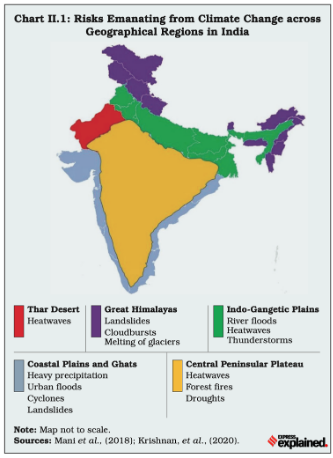Context:
In its latest report of currency and finance, the RBI has a chapter dedicated to answering many questions on the economic cost of climate change, vulnerability of India’s economy to such climate change and explaining the macroeconomic effects of climate change in India.
| Probable Question:
Q. Taking urgent action to combat climate change and its devastating impacts is an imperative to save lives and livelihood. In light of the statement, discuss the macroeconomic impacts that climate change will cause to the Indian economy. |
Evidence of Climate Change:
- The rise in annual average temperature in India has been significantly sharper during the last vicennial (twenty years) than during any other 20-year time interval since 1901.
- Annual average rainfall in India has gradually declined. While dry spells have become more frequent during the last several years, intense wet spells have also increased.
- Research about natural disasters since 1975 has shown that India is relatively more exposed to floods and storms (i.e., cyclones and hailstorms) than droughts and heatwaves.

Figure: Vulnerability of India to climate change
Macroeconomic Impact of Climate Change on India:
- Climate change can adversely impact both the supply side (read the productive potential) as well as the demand side. It can stroke inflation, reduce economic output, trigger uncertainty and change consumer behaviour.
- Water stress: According to Niti Aayog in 2019, around 600 million of India’s population are facing severe water stress, with 8 million children below 14 years in urban India at risk due to poor water supply.
- Job and productivity loss: The World Bank in 2020 said that India could account for 34 million of the projected 80 million global job losses from heat stress associated with productivity decline by 2030.
- Sea level rise:
-
- The IPCC Working Group in 2022 stated that India is one of the most vulnerable countries globally in terms of the population that would be affected by the sea level rise.
- By the middle of the present century, around 35 million people in India could face annual coastal flooding, with 45-50 million at risk by the end of the century.
- Transition risks: (These refer to economy-wide changes arising from the transition towards a low-carbon economy.)
-
- Moving towards net zero by 2050 will spike inflation far more in the immediate future than continuing on current policies.
- These trade-offs will become sharper as India tries to achieve the twin goals of achieving net zero emissions by 2070 and becoming an advanced economy (which implies higher emissions) by 2047.
News Source: Indian Express
![]() 16 May 2023
16 May 2023

